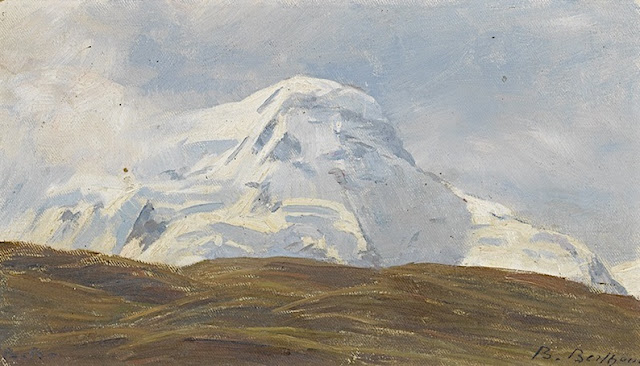GEORGIA O' KEEFFE (1887–1986)
Cerro Pedernal (3,006 m - 9,862 ft)
United State of America (New Mexico)
1. In Road to Pedernal, 1936, Georgia O'Keeffe Museum, Santa Fe
2. In Cerro Pedernal at dawn, 1936, Georgia O'Keeffe Museum, Santa Fe
3. In Pedernal from Ghost ranch, 1936, Georgia O'Keeffe Museum, Santa Fe
The mountain
Cerro Pedernal (3,006 m - 9,862 ft) locally known as just "Pedernal", is a narrow mesa in northern New Mexico (U.S.A). The name is Spanish for "flint hill". The mesa lies on the north flank of the Jemez Mountains, south of Abiquiu Lake, in the Coyote Ranger District of the Santa Fe National Forest. Cerro Pedernal is essentially a high, long butte created by a volcanic process. Viewed along its East-West line, it appears as a tall point rising out of the New Mexico desert, but viewed along its North-South vantage, its true shape is more apparent as a long ridge.
Pedernal is the source of a chert used by the prehistoric Gallina people. The native peoples of the area used the rock around this mountain for arrowheads and other tools.
Its cliffs are popular with rock climbers. Despite Cerro Pedernal's history and beauty, she is seldom climbed. The high butte is ringed by a long, sheer cliff band that seems impossible to climb unroped. Perhaps this is why few see her summit. However, there is a weakness in the cliffs that offers a short Class 4 scramble to the top. From the summit of Cerro Pedernal, you are afforded uncommon views. The Sangre de Cristo range is visible from Colorado to New Mexico. The Colorado 14er Culebra Peak is easily visible, as well as New Mexico's highest point, Wheeler Peak. On a clear day, the southern San Juan range in Colorado is visible, and even the La Platas around Durango. Ringing Cerro Pedernal is the Jemez range, which are mostly rolling mountains with lush greens. To the West is high desert landscape of deep red sandstone, blue rivers, and the tans and browns of the high desert. The summit of Cerro Pedernal is quite a spectacular spot.
The famous artist Georgia O'Keeffe used to live for a time in this area (Ghost Ranch) and painted Cerro Pedernal several times (more than 20 paintings). She referred to Pedernal as her "favorite mountain." Her ashes were scattered on its top.
The painter
Georgia O’Keeffe is one of the most significant and intriguing artists of the twentieth century, known internationally for her boldly innovative art. Her distinct flowers, dramatic cityscapes, glowing landscapes, and images of bones against the stark desert sky are iconic and original contributions to American Modernism.Born on November 15, 1887, the second of seven children, Georgia Totto O’Keeffe grew up on a farm near Sun Prairie, Wisconsin. She studied at the Art Institute of Chicago in 1905-1906 and the Art Students League in New York in 1907-1908. Under the direction of William Merritt Chase, F. Luis Mora, and Kenyon Cox she learned the techniques of traditional realist painting. The direction of her artistic practice shifted dramatically in 1912 when she studied the revolutionary ideas of Arthur Wesley Dow. Dow’s emphasis on composition and design offered O’Keeffe an alternative to realism. She experimented for two years, while she taught art in South Carolina and west Texas. Seeking to find a personal visual language through which she could express her feelings and ideas, she began a series of abstract charcoal drawings in 1915 that represented a radical break with tradition and made O’Keeffe one of the very first American artists to practice pure abstraction.
O’Keeffe mailed some of these highly abstract drawings to a friend in New York City, who showed them to Alfred Stieglitz. An art dealer and internationally known photographer, he was the first to exhibit her work in 1916. He would eventually become O’Keeffe’s husband.
In the summer of 1929, O’Keeffe made the first of many trips to northern New Mexico. The stark landscape, distinct indigenous art, and unique regional style of adobe architecture inspired a new direction in O’Keeffe’s artwork. For the next two decades she spent part of most years living and working in New Mexico . She made the state her permanent home in 1949, three years after Stieglitz’s death. O’Keeffe’s New Mexico paintings coincided with a growing interest in regional scenes by American Modernists seeking a distinctive view of America. Her simplified and refined representations of this region express a deep personal response to the high desert terrain.
In the 1950s, O’Keeffe began to travel internationally. She created paintings that evoked a sense of the spectacular places she visited, including the mountain peaks of Peru and Japan’s Mount Fuji. At the age of seventy-three she embarked on a new series focused on the clouds in the sky and the rivers below.
Suffering from macular degeneration and discouraged by her failing eyesight, O’Keeffe painted her last unassisted oil painting in 1972. But O’Keeffe’s will to create did not diminish with her eyesight. In 1977, at age ninety, she observed, “I can see what I want to paint. The thing that makes you want to create is still there.”
Late in life, and almost blind, she enlisted the help of several assistants to enable her to again create art. In these works she returned to favorite visual motifs from her memory and vivid imagination.
Georgia O’Keeffe died in Santa Fe, on March 6, 1986, at the age of 98.


























